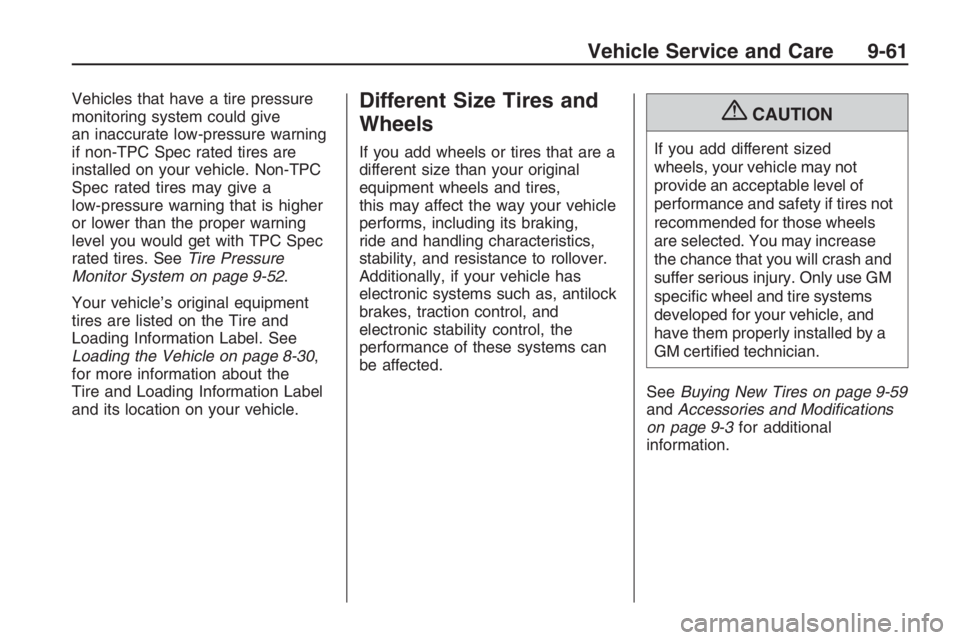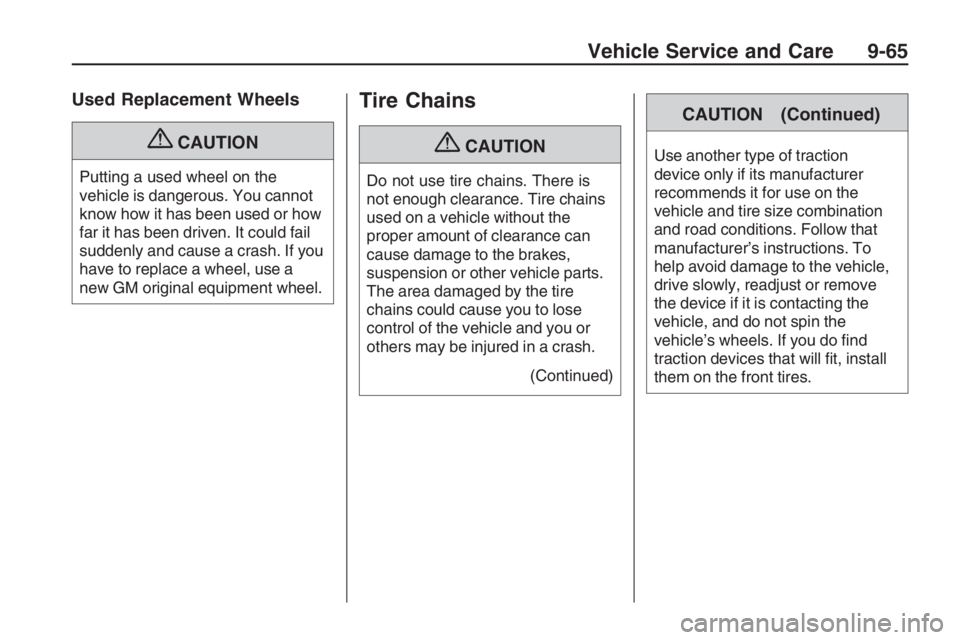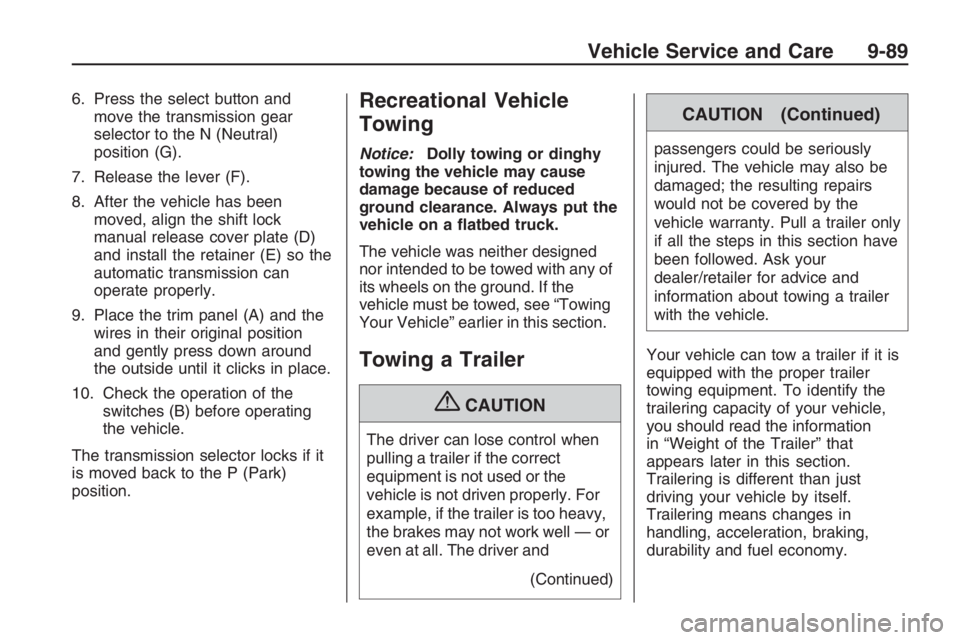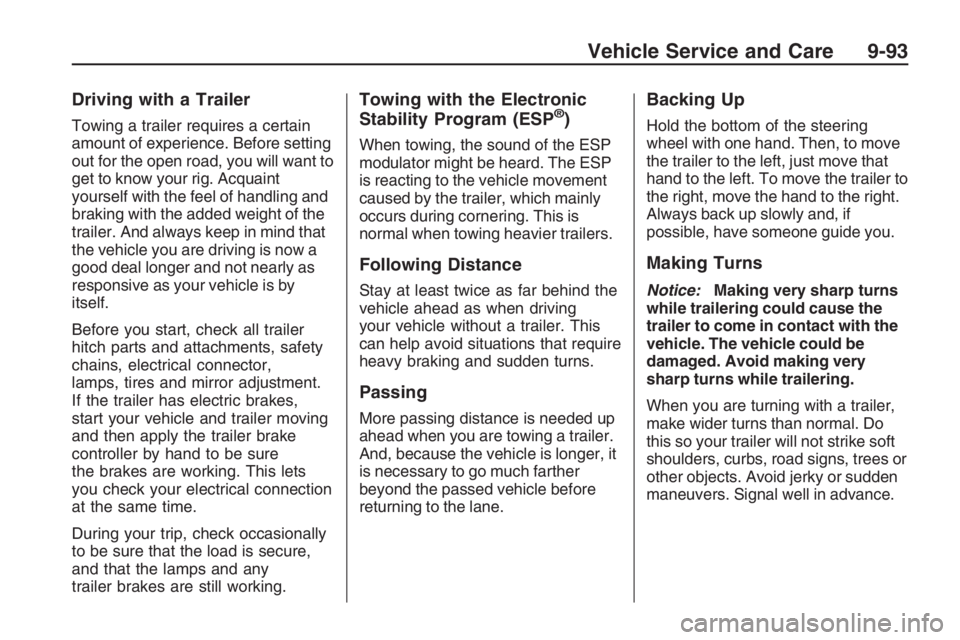2009 PONTIAC G8 brakes
[x] Cancel search: brakesPage 265 of 356

Vehicles that have a tire pressure
monitoring system could give
an inaccurate low-pressure warning
if non-TPC Spec rated tires are
installed on your vehicle. Non-TPC
Spec rated tires may give a
low-pressure warning that is higher
or lower than the proper warning
level you would get with TPC Spec
rated tires. SeeTire Pressure
Monitor System on page 9-52.
Your vehicle’s original equipment
tires are listed on the Tire and
Loading Information Label. See
Loading the Vehicle on page 8-30,
for more information about the
Tire and Loading Information Label
and its location on your vehicle.Different Size Tires and
Wheels
If you add wheels or tires that are a
different size than your original
equipment wheels and tires,
this may affect the way your vehicle
performs, including its braking,
ride and handling characteristics,
stability, and resistance to rollover.
Additionally, if your vehicle has
electronic systems such as, antilock
brakes, traction control, and
electronic stability control, the
performance of these systems can
be affected.
{CAUTION
If you add different sized
wheels, your vehicle may not
provide an acceptable level of
performance and safety if tires not
recommended for those wheels
are selected. You may increase
the chance that you will crash and
suffer serious injury. Only use GM
speci�c wheel and tire systems
developed for your vehicle, and
have them properly installed by a
GM certi�ed technician.
SeeBuying New Tires on page 9-59
andAccessories and Modifications
on page 9-3for additional
information.
Vehicle Service and Care 9-61
Page 269 of 356

Used Replacement Wheels
{CAUTION
Putting a used wheel on the
vehicle is dangerous. You cannot
know how it has been used or how
far it has been driven. It could fail
suddenly and cause a crash. If you
have to replace a wheel, use a
new GM original equipment wheel.
Tire Chains
{CAUTION
Do not use tire chains. There is
not enough clearance. Tire chains
used on a vehicle without the
proper amount of clearance can
cause damage to the brakes,
suspension or other vehicle parts.
The area damaged by the tire
chains could cause you to lose
control of the vehicle and you or
others may be injured in a crash.
(Continued)
CAUTION (Continued)
Use another type of traction
device only if its manufacturer
recommends it for use on the
vehicle and tire size combination
and road conditions. Follow that
manufacturer’s instructions. To
help avoid damage to the vehicle,
drive slowly, readjust or remove
the device if it is contacting the
vehicle, and do not spin the
vehicle’s wheels. If you do �nd
traction devices that will �t, install
them on the front tires.
Vehicle Service and Care 9-65
Page 293 of 356

6. Press the select button and
move the transmission gear
selector to the N (Neutral)
position (G).
7. Release the lever (F).
8. After the vehicle has been
moved, align the shift lock
manual release cover plate (D)
and install the retainer (E) so the
automatic transmission can
operate properly.
9. Place the trim panel (A) and the
wires in their original position
and gently press down around
the outside until it clicks in place.
10. Check the operation of the
switches (B) before operating
the vehicle.
The transmission selector locks if it
is moved back to the P (Park)
position.Recreational Vehicle
Towing
Notice:Dolly towing or dinghy
towing the vehicle may cause
damage because of reduced
ground clearance. Always put the
vehicle on a �atbed truck.
The vehicle was neither designed
nor intended to be towed with any of
its wheels on the ground. If the
vehicle must be towed, see “Towing
Your Vehicle” earlier in this section.
Towing a Trailer
{CAUTION
The driver can lose control when
pulling a trailer if the correct
equipment is not used or the
vehicle is not driven properly. For
example, if the trailer is too heavy,
the brakes may not work well — or
even at all. The driver and
(Continued)
CAUTION (Continued)
passengers could be seriously
injured. The vehicle may also be
damaged; the resulting repairs
would not be covered by the
vehicle warranty. Pull a trailer only
if all the steps in this section have
been followed. Ask your
dealer/retailer for advice and
information about towing a trailer
with the vehicle.
Your vehicle can tow a trailer if it is
equipped with the proper trailer
towing equipment. To identify the
trailering capacity of your vehicle,
you should read the information
in “Weight of the Trailer” that
appears later in this section.
Trailering is different than just
driving your vehicle by itself.
Trailering means changes in
handling, acceleration, braking,
durability and fuel economy.
Vehicle Service and Care 9-89
Page 296 of 356

Total Weight on Your Vehicle’s
Tires
Be sure your vehicle’s tires are
in�ated to the upper limit for cold
tires. You will �nd these numbers on
the Tire-Loading Information label.
SeeLoading the Vehicle on
page 8-30. Then be sure you do not
go over the GVW limit for your
vehicle, including the weight of the
trailer tongue.
Hitches
It is important to have the correct
hitch equipment. Crosswinds,
large trucks going by and rough
roads are a few reasons why
you will need the right hitch. Here
are some rules to follow:
The rear bumper on your vehicle
is not intended for hitches. Do not
attach rental hitches or other
bumper-type hitches to it. Use
only a frame-mounted hitch that
does not attach to the bumper.
Will you have to make any holes
in the body of your vehicle when
you install a trailer hitch? If you
do, then be sure to seal the holes
later when you remove the hitch.
If you do not seal them, deadly
carbon monoxide (CO) from your
exhaust can get into your vehicle.
SeeEngine Exhaust on
page 8-14. Dirt and water can
also enter the vehicle.
Safety Chains
You should always attach chains
between your vehicle and your
trailer. Cross the safety chains under
the tongue of the trailer so that the
tongue will not drop to the road if it
becomes separated from the hitch.
Instructions about safety chains may
be provided by the hitch
manufacturer or by the trailer
manufacturer. Follow the
manufacturer’s recommendation for
attaching safety chains and do not
attach them to the bumper. Alwaysleave just enough slack so you can
turn with your rig. And, never allow
safety chains to drag on the ground.
Trailer Brakes
Does your trailer have its own
brakes? Be sure to read and follow
the instructions for the trailer
brakes so you will be able to install,
adjust and maintain them properly.
Because you have anti-lock brakes,
do not tap into your vehicle’s brake
system. If you do, both brake
systems will not work well, or at all.
Trailer Wiring Harness
All of the electrical circuits required
for your trailer lighting system can be
accessed at the driver’s side rear
lamp connector. This connector is
located under the carpet on the rear
corner of the trunk compartment.
9-92 Vehicle Service and Care
Page 297 of 356

Driving with a Trailer
Towing a trailer requires a certain
amount of experience. Before setting
out for the open road, you will want to
get to know your rig. Acquaint
yourself with the feel of handling and
braking with the added weight of the
trailer. And always keep in mind that
the vehicle you are driving is now a
good deal longer and not nearly as
responsive as your vehicle is by
itself.
Before you start, check all trailer
hitch parts and attachments, safety
chains, electrical connector,
lamps, tires and mirror adjustment.
If the trailer has electric brakes,
start your vehicle and trailer moving
and then apply the trailer brake
controller by hand to be sure
the brakes are working. This lets
you check your electrical connection
at the same time.
During your trip, check occasionally
to be sure that the load is secure,
and that the lamps and any
trailer brakes are still working.
Towing with the Electronic
Stability Program (ESP®)
When towing, the sound of the ESP
modulator might be heard. The ESP
is reacting to the vehicle movement
caused by the trailer, which mainly
occurs during cornering. This is
normal when towing heavier trailers.
Following Distance
Stay at least twice as far behind the
vehicle ahead as when driving
your vehicle without a trailer. This
can help avoid situations that require
heavy braking and sudden turns.
Passing
More passing distance is needed up
ahead when you are towing a trailer.
And, because the vehicle is longer, it
is necessary to go much farther
beyond the passed vehicle before
returning to the lane.
Backing Up
Hold the bottom of the steering
wheel with one hand. Then, to move
the trailer to the left, just move that
hand to the left. To move the trailer to
the right, move the hand to the right.
Always back up slowly and, if
possible, have someone guide you.
Making Turns
Notice:Making very sharp turns
while trailering could cause the
trailer to come in contact with the
vehicle. The vehicle could be
damaged. Avoid making very
sharp turns while trailering.
When you are turning with a trailer,
make wider turns than normal. Do
this so your trailer will not strike soft
shoulders, curbs, road signs, trees or
other objects. Avoid jerky or sudden
maneuvers. Signal well in advance.
Vehicle Service and Care 9-93
Page 298 of 356

Turn Signals When Towing a
Trailer
When you tow a trailer, your vehicle
may need a different turn signal
�asher and/or extra wiring. Check
with your dealer/retailer. The arrows
on your instrument panel will �ash
whenever you signal a turn or lane
change. Properly hooked up, the
trailer lamps will also �ash, telling
other drivers you are about to turn,
change lanes or stop.
When towing a trailer, the arrows on
your instrument panel will �ash
for turns even if the bulbs on the
trailer are burned out. Thus,
you may think drivers behind you
are seeing your signal when
they are not. It is important to check
occasionally to be sure the trailer
bulbs are still working.
Your vehicle has bulb warning
lights. When you plug a trailer
lighting system into your vehicle’s
lighting system, its bulb warning
lights may not let you know if one of
your lamps goes out. So, whenyou have a trailer lighting system
plugged in, be sure to check
your vehicle and trailer lamps from
time to time to be sure they are
all working. Once you disconnect the
trailer lamps, the bulb warning
lights again can tell you if one of
your vehicle lamps is out.
Driving On Grades
Reduce speed and shift to a lower
gearbeforeyou start down a long or
steep downgrade. If you do not shift
down, you might have to use your
brakes so much that they would get
hot and no longer work well.
On a long uphill grade, shift down to
a lower gear and reduce your
speed to around 45 mph (70 km/h)
to reduce the possibility of engine
and transmission overheating.
Parking on Hills
{CAUTION
Parking the vehicle on a hill with
the trailer attached can be
dangerous. If something goes
wrong, the rig could start to move.
People can be injured, and both
the vehicle and the trailer can be
damaged. When possible, always
park the rig on a �at surface.
But if you ever have to park your rig
on a hill, here is how to do it:
1. Apply your regular brakes, but do
not shift into P (Park) yet.
2. Have someone place chocks
under the trailer wheels.
3. When the wheel chocks are in
place, release the regular brakes
until the chocks absorb the load.
4. Reapply the regular brakes.
Then apply your parking
brake, and then shift to P (Park).
5. Release the regular brakes.
9-94 Vehicle Service and Care
Page 299 of 356

When You Are Ready to Leave
After Parking on a Hill
1. Apply your regular brakes and
hold the pedal down while you:
Start your engine.
Shift into a gear.
Release the parking brake.
2. Let up on the brake pedal.
3. Drive slowly until the trailer is
clear of the chocks.
4. Stop and have someone pick up
and store the chocks.
Maintenance When Trailer
Towing
Your vehicle will need service more
often when you’re pulling a trailer.
See the Maintenance Schedule for
more on this. Things that are
especially important in trailer
operation are automatic transmission
�uid (don’t over�ll), engine oil, drivebelt, cooling system and brake
system. Each of these is covered in
this manual, and the Index will help
you �nd them quickly. If you’re
trailering, it’s a good idea to review
this information before you start
your trip.
Check periodically to see that all
hitch nuts and bolts are tight.
Engine Cooling When Trailer
Towing
Your cooling system may
temporarily overheat during severe
operating conditions. SeeEngine
Overheating on page 9-20.
Appearance Care
Interior Cleaning
Your vehicle’s interior will continue to
look its best if it is cleaned often.
Although not always visible, dust and
dirt can accumulate on your
upholstery. Dirt can damage carpet,
fabric, leather, and plastic surfaces.
Regular vacuuming is recommended
to remove particles from the
upholstery. It is important to keep
your upholstery from becoming and
remaining heavily soiled. Soils
should be removed as quickly as
possible. Your vehicle’s interior may
experience extremes of heat that
could cause stains to set rapidly.
Lighter colored interiors may require
more frequent cleaning. Use care
because newspapers and garments
that transfer color to your home
furnishings may also transfer color
to your vehicle’s interior.
Vehicle Service and Care 9-95
Page 318 of 356

(e)Make sure the safety belt
reminder light and safety belt
assemblies are working properly.
Look for any other loose or damaged
safety belt system parts. If you see
anything that might keep a safety belt
system from doing its job, have it
repaired. Have any torn or frayed
safety belts replaced. Also see
Airbag System Check on page 1-33.
(f)Lubricate all key lock cylinders,
door hinges and latches, hood
hinges and latches and trunk lid
hinges and latches. More frequent
lubrication may be required when
exposed to a corrosive environment.
Applying silicone grease on
weatherstrips with a clean cloth will
make them last longer, seal
better, and not stick or squeak.
(g)Visually inspect belt for fraying,
excessive cracks, or obvious
damage. Replace belt if necessary.(h)Change automatic transmission
fluid and filter if the vehicle is
mainly driven under one or more of
these conditions:
�In heavy city traffic where the
outside temperature regularly
reaches 90°F (32°C) or higher.
�In hilly or mountainous terrain.
�When doing frequent trailer
towing.
�Uses such as found in taxi,
police, or delivery service.
(i)Drain, flush, and refill cooling
system. This service can be
complex; you should have your
dealer/retailer perform this service.
See Engine Coolant on page 9-15
for what to use. Inspect hoses.
Clean radiator, condenser, pressure
cap, and filler neck. Pressure test the
cooling system and pressure cap.(j)A fluid loss in any vehicle system
could indicate a problem. Have the
system inspected and repaired and
the fluid level checked. Add fluid
if needed.
(k)If you drive regularly under dusty
conditions, inspect the filter at
each engine oil change.
(l)If you drive regularly under dusty
conditions, the filter may require
replacement more often.
(m)Drain, flush, and refill brake
hydraulic system at a regular service
interval (IorII) every two years.
This service can be complex;
you should have your dealer/retailer
perform this service. See Brakes
on page 9-25.
11-8 Service and Maintenance